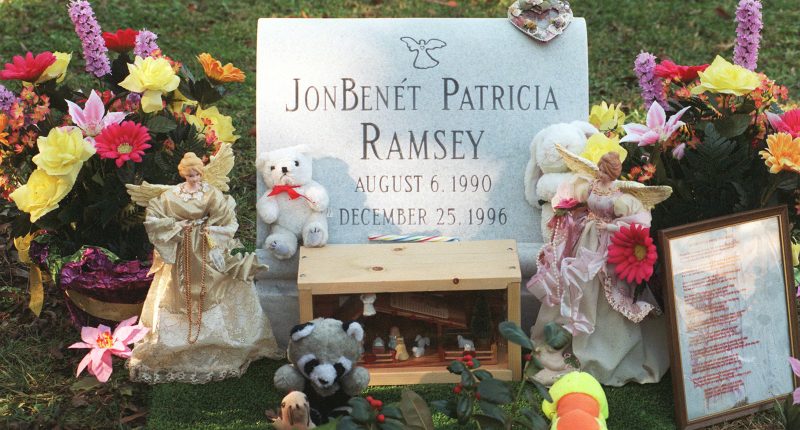The murder of JonBenét Ramsey was one of the last and most compelling of the 20th century’s “crimes of the century.” Six-year-old JonBenet was reported missing the morning of December 26, 1996; she was later found dead of strangulation in her home’s basement.
Advertisement
The case had everything it needed to become an American fascination: an innocent victim; a cryptic ransom demand; the controversial world of child beauty pageants; a wealthy and privileged family brought low by tragedy and suspicion; and finally, the fact that the killer has yet to be publicly identified. False confessions, theories ranging from the fringe to the credible, and the hope that JonBenét’s death may be avenged and other children kept safe have kept the case making occasional headlines in the decades after the initial investigation and its associated press frenzy. (The City of Boulder, for its part, also continues to give regular updates.) Hope continues that the next big headline the case makes will be the one that trumpets an arrest.
Advertisement
Her parents were formally cleared …
Perhaps inevitably, after a suspect was not quickly identified, suspicion settled on JonBenét Ramsey’s family. Parents John and Patsy and brother Burke were the only people known to be in the house late Christmas night or early the following morning, giving them obvious opportunities to commit the crime even if a motive was not apparent. John Ramsey blamed some of the suspicion he and his family faced on the media, claiming a hunger for ratings had helped keep the story alive. That said, Boulder Police had themselves acknowledged the suspicions and did not immediately discount them.
Advertisement
In 2008, Boulder County District Attorney Mary Lacy gave a statement clearing the immediate family of suspicion, largely on the basis of touch DNA that had been recovered from the clothing JonBenét wore at the time of her murder. This DNA seemed to finally prove the presence of an outsider in the home in close proximity to the victim, no less. Lacy went even further, apologizing for the decade of suspicion and speculation the Ramseys had faced.
Lacy’s statement attempting to formally rule out the family followed a 2003 finding by a judge overseeing a defamation trial involving the surviving Ramseys, indicating that the theory that an intruder had killed the child best fit the available evidence. Lacy had publicly agreed.
Advertisement
But not without controversy
Despite prosecutor Mary Lacy’s public comments that JonBenét Ramsey’s surviving family members were no longer considered suspects in the child’s murder, subsequent public speculation has never abandoned the theory that the Ramseys were involved. Lacy, after all, can only speak for her own office, which itself took a decade to issue a statement attempting to clear the Ramseys.
Advertisement
In 2016, Boulder District Attorney Stan Garnett, who had taken over the case, threw a bit of cold water on Lacy’s (then eight-year-old) statement, telling People magazine that though “John, Burke, the Ramsey family are totally covered by the presumption of innocence … to issue an exoneration is, I think, misleading.” He went on to praise Lacy while continuing to criticize her decision to release the letter clearing the Ramseys, noting both the complexity of the case and the fact that the crime scene was badly compromised during the initial investigation.
Calling the exoneration decision “unusual,” Garnett promised to continue looking for technological advances that might allow more fruitful examination of the DNA evidence. He also managed expectations: “I don’t anticipate that it’s going to lead to any dramatic developments in the case … but obviously we would love to solve it.”
Advertisement
Patsy Ramsey died in 2006
Both those who considered her a grieving mother wronged by the media and others convinced of her involvement in JonBenét Ramsey’s death felt Patsy Ramsey’s 2006 death was an injustice. Depending on people’s views of the case, Patsy’s death either allowed her to escape consequences or robbed her of the chance to see the law brought to bear on her child’s killer.
Advertisement
Patsy Ramsey had first been diagnosed with ovarian cancer in 1993, well before JonBenét’s death. (According to statistics compiled by the National Cancer Institute and reported by St. Luke’s, 46% of women diagnosed with ovarian cancer will survive at least five years, though of course individual circumstances vary; Patsy’s 13-year survival made her lucky, at least in this respect.) News reports of Patsy’s death indicated that her cancer had recurred in 2003, and that she died in her father’s home with her husband present. She was 49. Sadly for her supporters, Patsy died two years before Mary Lacy’s letter exonerating the family from involvement in the murder was made public.
A popular theory points to her brother
Sharp-eyed readers will note that statements about the Ramsey family’s guilt or innocence often name her brother Burke. Why emphasize that her brother, 9 years old at the time of her death, is not the killer? Burke has, unfortunately, emerged as a popular suspect in his sister’s death, at least according to armchair detectives.
Advertisement
According to this theory, Burke killed his little sister by accident. The idea goes that JonBenét, in the manner of little sisters everywhere, had helped herself to a piece of the pineapple Burke was having for a late-night snack, which allegedly so enraged him that he struck her with a flashlight. This head injury was what killed her: the strangulation, ransom note, and discovery of the corpse in the home’s basement were all allegedly staged by the Ramseys in order to protect their son. The theory is arguably compelling but apparently not provable, as Burke has never faced charges in his sister’s death; furthermore, the public accusation of a child for a sibling’s murder in the absence of such evidence could certainly make some observers queasy.
Advertisement
Fans of this theory claim it explains Burke’s supposedly odd behavior and flat affect when discussing the case, as well as undisturbed cobwebs across a window an intruder would probably have used. After a documentary on this theory aired in 2016, Burke sued CBS and a pathologist involved, also appearing on “Dr. Phil” to proclaim his innocence. The lawsuits’ settlements have not been publicly disclosed.
Another theory connects the murder to an unsolved attack later that year
Another theory connects JonBenét Ramsey’s murder to another crime the next year: the sexual assault of a Boulder girl, called “Amy” in news reports to protect her privacy. Amy, then 12, was raped by a black-clad man who snuck into her home; her mother heard voices from Amy’s room and entered, interrupting the attack and forestalling any worse outcomes.
Advertisement
Amy’s attack took place in September 1997, less than a year after the Ramsey murder, and bears a number of similarities: Camel-brand cigarette butts found outside the crime scene, a stealthy intruder, and a young victim. Amy had apparently been specifically targeted, as the assailant addressed her by name during the attack. JonBenét and Amy had also known each other, at least superficially, as they attended the same dance school.
Amy’s father, also anonymous in news reports apparently to protect his daughter’s privacy, excoriated the Boulder police for their perceived incompetence. He argued that they failed to take evidence collection seriously, using a handprint found at the scene of the attack only to rule him out as his daughter’s assailant, refusing to test cigarette butts, and denying a request for Amy to view a photo lineup of registered sex offenders in the area. Amy’s father and a detective he hired further claimed to have evidence of a series of burglaries, home invasion, and assaults during the timespan surrounding the attacks on JonBenét and Amy, but these have not been connected to either case by authorities.
Advertisement
John Mark Karr confessed to the killing
In 2006, the murder of JonBenét Ramsey briefly appeared to have been solved with the confession of John Mark Karr. Karr, 41 years old in 2006, certainly seemed to fit the bill. He had been arrested on charges of possession of child sex abuse images (inexplicably a misdemeanor charge) in 2001, and was apparently obsessed with both the Ramsey case and that of Polly Klaas, a 12-year-old girl who was kidnapped and murdered in 1993. Karr had written creepy emails to a journalism professor who had produced documentaries on the Ramsey case, including the deeply disturbing lines “Sometimes little girls are closer to me than with their parents or any other person in their lives. When I refer to myself as JonBenét’s Closest, maybe now you understand.”
Advertisement
The final Agatha Christie-like clue was that Karr had once signed a yearbook with a phrase that may have been linked to “S.B.T.C.,” the acronym used to sign the ransom note found in the Ramsey house. Karr himself claimed to have been in the Ramsey home on the night of the murder, though claimed the death was accidental. Given all this, Karr was extradited from Thailand to face charges in the United States.
But the case fell apart. There was no way to tie Karr to Colorado, and the DNA recovered from JonBenét’s clothing did not match a sample from Karr. The whole affair seemed to be an especially disheartening example of the false confession phenomenon. In 2025, Karr was said to be living quietly outside the United States and was rumored to have transitioned, though a website still used the url johnmarkkarr.com. Among the AI images and photos of young, female murder victims, Ramsey and Klaas among them, are Karr’s denials that he has ever led a cult.
Advertisement
And so did Gary Oliva
John Mark Karr wasn’t the only unsavory character to present himself as the killer. Gary Oliva, a convicted sex criminal whose cache of child abuse images included media related to JonBenét, had been on investigators’ radar before, even appearing on a 2002 “48 Hours Investigates” special about the murder and admitting he had written a poem about the dead girl. Oliva was probably in Colorado at the time and had assaulted a child before, but his DNA did not match any found at the scene.
Advertisement
Oliva had called an old high school pal, Michael Vail, shortly after the murder and spoken of having hurt a little girl. Vail had informed police, and in later press statements would also tie the murder weapon to Oliva. JonBenét had been strangled with a cord tightened by being turned around a paintbrush handle, which reminded Vail of Oliva’s old predilection for knots and habit of carrying around paintbrushes. Oliva also apparently once tried to strangle his own mother.
Oliva continued to write to Vail (and send audiotapes!) and kept referencing the Ramsey case. Released in 2024 from a prison sentence for crimes related to child sex abuse images, Oliva has only intermittently checked in per his parole and is officially listed as a transient.
Advertisement
Child beauty pageants continue and remain controversial
One of the aspects of the JonBenét Ramsey case that most titillated American society was the victim’s successful participation in a number of child beauty pageants. In the years following, the events have become controversial even as media around them has proliferated: TLC’s reality show about the subculture, “Toddlers and Tiaras,” ran for a camptastic and heavily memed seven seasons; conceptually similar “Dance Moms” lasted nine.
Advertisement
A 1999 “Good Housekeeping” article focusing on child pageant contestants, including friends (and competitors) of JonBenét Ramsey, references the public criticism leveled at pageant families while reporting makeup hacks. (It takes 14 coats of mascara to match the pop of a good set of false lashes.) The mothers interviewed cited broadly feminine “soft skills” like poise and decorum as benefits to the almost universally female participants, along with the ’90s trope of keeping kids away from drugs and gangs. JonBenét’s death made families jittery, though: Fear of both copycats and backlash made pageant families more secretive and more eager to de-glam their daughters right after their performances were complete.
Advertisement
A friend of the Ramseys pranked investigating officers
Stress makes otherwise sane people do strange things. How else to explain the behavior of Ramsey family friend Susan Stine, who set up a fake Hotmail account so she could pretend to be a policeman involved in the case and, in this guise, correspond with journalists?
Advertisement
Per an archived press release from the Boulder city government, in 2003 Stine set up a fake account in the name of Boulder police chief Mark Beckner and used it to email a local columnist who had recently written about the case. The columnist, Charlie Brennan, was suspicious and reached out to the police department, who confirmed that the email was a fake. Investigators then tracked the IP address (which most people likely didn’t know about in 2003) and linked activity on the email account to a single dial-up account in Georgia, registered to Stine. Stine was not only a close friend of the Ramseys but had also been interviewed regarding the case. Brennan was not the only person Stine had written as “Beckner,” and some of the messages were described as “nonsensical,” which might well describe the whole incident.
Advertisement
Stine refused to cooperate with the Georgia Bureau of Investigation’s inquiry. She did, however, send an email to Beckner (presumably from another address) apologizing for what she called a “sophomoric prank.”
The story has been the subject of various books and documentaries
The JonBenét Ramsey case has never been far from the headlines since Patsy Ramsey’s first call to the police. Books, TV episodes, podcasts, and even YouTube retellings of the circumstances of notable crimes have all been devoted to the case. The Ramseys themselves even wrote a book, “The Death of Innocence,” published in 2001; it made the New York Times bestseller list and clocks in at an intimidating 448 pages in paperback.
Advertisement
The media saturation has been so dense that it’s even created metanarratives. Alan Prendergast, a writer for Denver-area publication Westword, compiled his own 20-year retrospective of media coverage, and plenty more has come out since that anniversary. Stephanie Holland, writing in The Root, notes that Ramsey remains in headlines while Black girls’ murders and disappearances quickly fade: JonBenét’s death has never been solved, but nor do we yet know what happened to Asha Degree, and it’s the blond girl who got the new docuseries. There has even been scholarly examination of the media coverage of the Ramsey case, with journals in law and American studies presenting articles addressing aspects of the case.
Advertisement
Even if and when a killer is caught, the public interest seems unlikely to abate. JonBenét will likely remain in the strange, sad company of those who became world famous, but only after their deaths.
New optimism has emerged about the potential for a solution
In late 2024, as excitement began to build about “Cold Case: Who Killed JonBenét Ramsey?,” a high-profile new Netflix docuseries about the crime, the Boulder police department reiterated that they continue to investigate the case. They hinted at unspecified progress and noted that tips continue to trickle in. Given that investigation continues, the comments were light on details, but the department did defend itself against rumors that potential sources of DNA evidence have never been tested or that other viable leads had not been followed up.
Advertisement
John Ramsey continues to speak publicly about the case, and told CNN in January 2025 that he was optimistic that DNA advances could finally crack the now-28-year-old-case, pointing to the high-profile takedown of the Golden State Killer through exploration of familial DNA in databases. Though Ramsey has been critical of the Boulder Police Department and its investigation over the years, he states that he now has more confidence in the force under its new chief, Stephen Redfearn.
Ramsey, 81 at the time of the interview, said he hoped to have an answer before his death, noting that clarity would ease the lives of his surviving children and his grandchildren. He pleaded for any information a member of the public may have to be forwarded to the authorities in order to finally close the case.
Advertisement
If you or anyone you know has been or may be the victim of child abuse or sexual assault, contact the relevant resources below:





